- The main objective of education in the twenty-first century is the growth of Critical and Creative thinking.
- This presentation’s objective is to help teachers in offering learners all the scaffolding and support they need to enhance their capacity for higher-order thinking.
- Our efforts should be directed at helping our pupils think more clearly.
- The path that will lead to enhanced thinking will be provided by Revised Bloom’s Taxonomy.
Let’s now study who was involved in the revision and modification of Bloom’s Taxonomy.
David Krathwohl and Lorin Anderson, who together presented the revised Bloom’s Taxonomy in 2001, are two of them. Lorin Anderson is a former student of Benjamin Samuel Bloom.
Three major categories can be used to group these modifications:
Terminology:-
Lorin Anderson Modifiedà Nouns to Verbs: Categories in Bloom’s Taxonomy
And renamed
- Knowledge into Remembering
- Comprehension into Understanding
- Synthesis into Creating
Structure:-
The position of synthesis in the triangle under the heading of “Creating” was also changed by Anderson.
Emphasis:-
In the revised Bloom’s taxonomy, Anderson additionally took into account two dimensions, known as “Knowledge” and “Cognitive Processes” in the knowledge matrix.
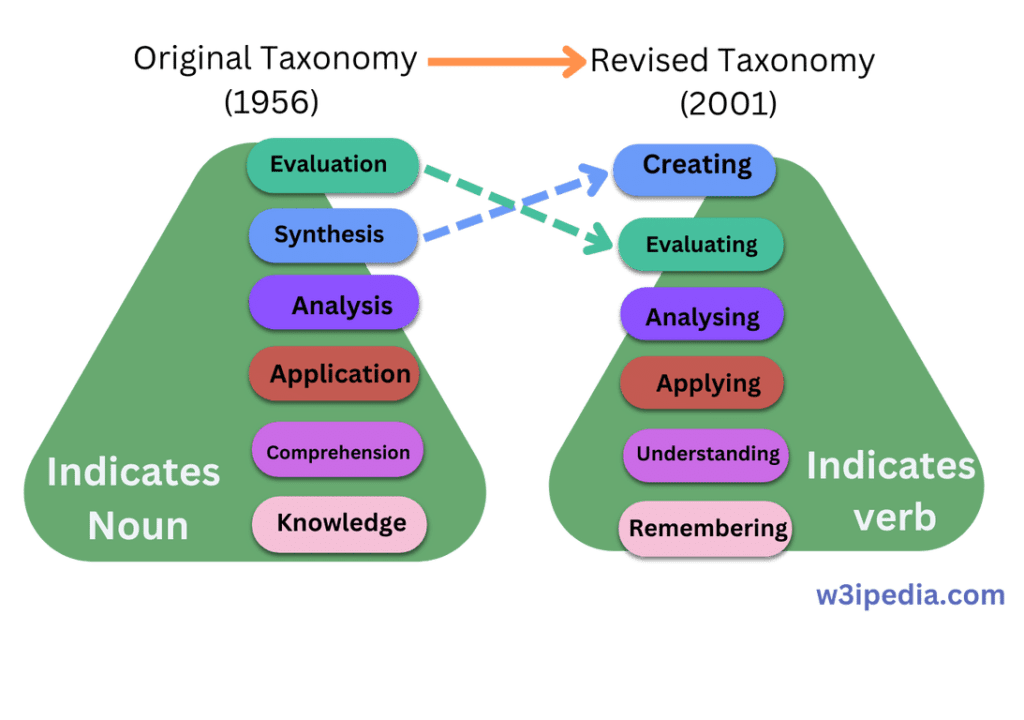
Table of Contents
Toggle1st Level: – Remembering
Recognizing or bringing back knowledge from memory is part of remembering. When memory is utilized to create or recall definitions, facts, or lists, or to recite previously learned material, this is referred to as remembering.
| Recognizing | Retrieving | |
| Listing | Naming | |
| Describing | Locating | |
| Identifying | Finding |
Can you remember the details?
Keywords (Verbs)
| List | Recite specific information |
| Listen | Distinguish |
| Memorize | Give example |
| Relate | Review |
| Group Recall or | Reproduce |
| Show | Quote |
| Choose recognition of | Quote |
| Locate | Record |
| Repeat | Match |
Product Includes
| Quiz | Label |
| Definition | List |
| Fact | Workbook |
| Worksheet | Reproduction |
| Test | Vocabulary |

Remembering: Participation Activities and Products
- Create a timeline of the story’s major developments.
- List the events of your normal day.
- Develop a concept map for the subject.
- List the keywords you are familiar with.
- Who played what roles in the narrative?
- Make a chart to illustrate, composing an acrostic poem.
- Read a poem you are familiar with.
2nd Level: UNDERSTANDING
Understanding By interpreting and translating what has been learned, the learner is able to understand the significance of the knowledge.
- Interpreting
- Exemplifying
- Summarizing
- Inferring
- Paraphrasing
- Classifying
- Comparing
- Explaining
Can you describe concepts or ideas?
Keywords (Verbs)
| Restate | Describe |
| Identify | Report |
| Discuss | Retell |
| Review | Research |
| Observe | Outline |
| Outline |
Products include:
| Translate | Interpret |
| Recitation | Example |
| Summary | Quiz |
| Collection | List |
| Reorganize | Explanation |
| Define | Show and Tell |
| Outline |
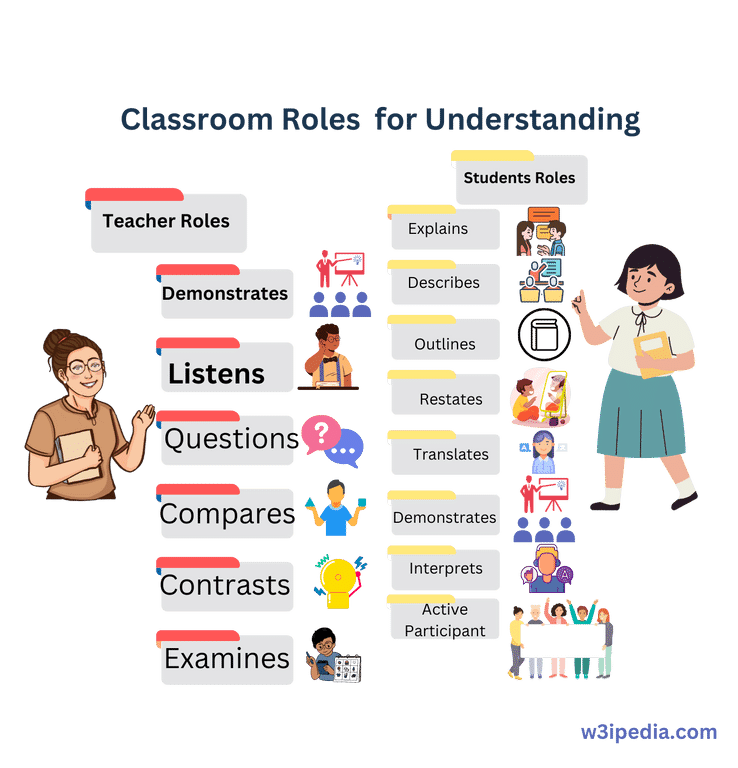
Understanding: – Participation Activities and Products
- Write a personal words statement.
- Draw or cut out drawings to represent a certain story occurrence.
- To the class, report.
- Explain what you believe the key point to be.
- Create a comic strip that depicts the story’s events in order.
- Create and stage a play based on the story.
- To help someone else understand this tale, create a concise summary.
- Describe the rationale behind the character’s choice of resolution for the issue.
- Make a report of the event’s highlights.
- Create a flowchart to show the events as they happened.
- Construct a coloring book.
- This book’s chapter should be cited.
- In your own words, recount.
- List the key points.
Third level: Applying
Information is used by the learner in a context that is distinct from the one in which it was learned.
- Implementing
- Carrying out
- Using
- Executing
Can you apply the knowledge to a similar, familiar circumstance?
Keyword Verbs
| Manipulate | Show |
| Solve | Solve |
| Solve | Adapt |
| Demonstration | Manipulate |
| Calculate | Demonstrate |
| Exhibit | Calculate |
| Interpret | Interpret |
| Interpret | Sculpture |
| Journal | Exhibit |
| Solve | Sequence |
| Translate | Collect |
| Collect | Collect |
| Diary | Translate |
| Sequence | Interpret |
| Illustrate | Paint |
| Make | Make |
| Make | Interview |
| Paint | Illustrate |
| Collect |
Products include
| Practice | Illustration |
| Performance | Interview |
| Dramatize | Interview |
| Operate | Draw |
| Photograph | Apply |
| Adapt | Demonstration |
| Presentation | Use |
| Sculpture | Journal |
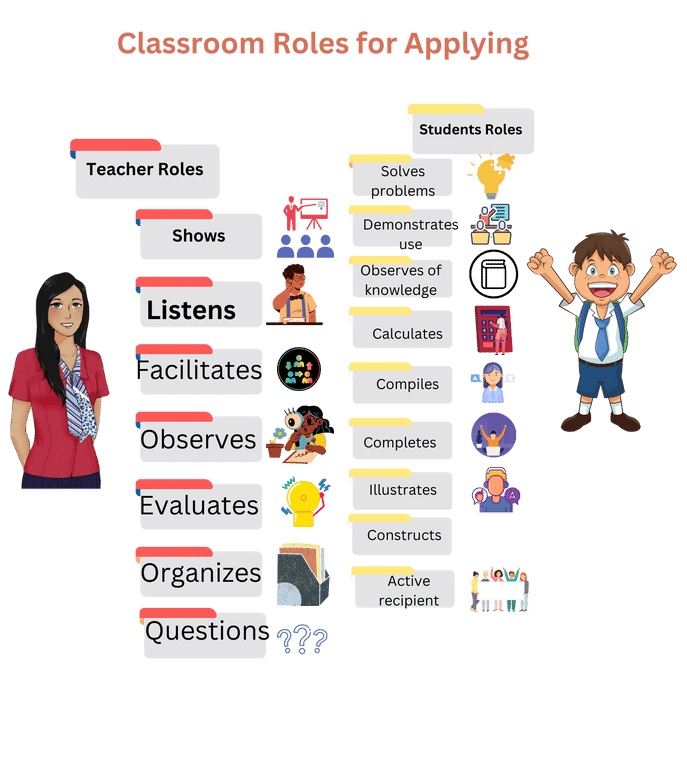
Applying: – Participation Products and Activities
- Create a model to show how it appears or functions.
- Perform a play for the students after practicing it.
- Create a diorama to depict a particular event.
- Write a journal entry.
- Create a scrapbook with information on the subject.
- Make invitations for a fictional character’s birthday celebration.
- Map out the topography.
- Create and present a photo gallery on a specific subject.
- Create a game or puzzle around the subject.
- For others, explain this subject in writing.
- Put a doll in a national outfit.
- Create a clay model.
- Use the same supplies to create a mural.
- Continue the story
4th Level:-Analyzing (dividing up into parts and forms)
Analyzing means breaking ideas or materials into their component parts and figuring out how those parts interact, relate to one another, or relate to a larger structure or goal.
To better understand knowledge, the learner dissects it into its component parts.
- Trying to compare
- Trying to organize
- Deconstructing
- Attributing
- Outlining
- Trying to find
- Structuring
Can you separate information into parts to study linkages and understandings?
Keywords Verbs
| Distinguish | Appraise |
| Order | Test |
| Categorize | Investigate |
| Criticize | Compare |
| Survey Breaking | Probe |
| Inquire | Research |
| Diagram | Discriminate |
| Question | Experiment |
| Sequence | Debate |
| Sift | Relate |
Analyze Products include
| Graph | Checklist |
| Outline | Survey |
| Mobile | Report |
| Spreadsheet | Chart |
| Evaluating | Database |
| Abstract |
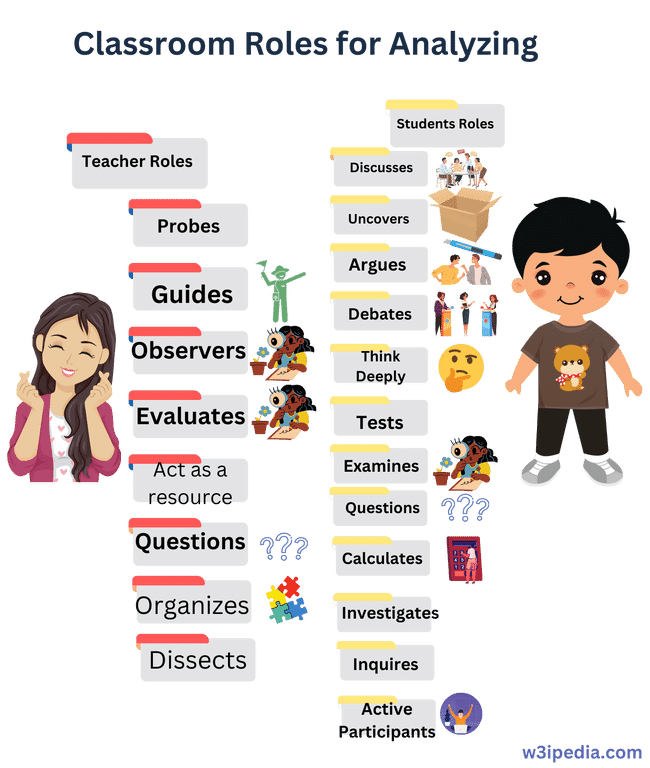
Analyzing: – Participation Activities and Products
- Use a Venn diagram to illustrate the similarities and differences between the two topics.
- Ask your classmates about a certain topic to get their opinions.
- To collect information, create a questionnaire.
- Assess the results.
- Create a flowchart to display the important steps.
- Write a report about the subject of the study.
- From the scenario, create a sociogram (a graphical picture).
- Create a graph to represent a certain piece of information.
- Create a family tree that shows the connections.
- Create a role-play based on the study topic.
- Create a biography of the person you are studying.
- create a graph
- Make an investigation to gather data to back up a position.
- Analyze the form, color, and texture of a piece of art.
5th Level: Evaluating
Evaluating the learner bases his or her choices on thorough analysis, critique, and evaluation.
- Checking / Verifying
- Hypothesizing / Speculating
- Critiquing
- Going to experiment
- Judging
- Testing
- Detecting/identifying
- Monitoring
Can you support your choice of action or course of action?
Keywords Verbs
| Judge | Choose | Rate |
| Conclude | Validate | Deduce |
| Predict | Debate | Assess |
| Justify | Score | Revise |
| Discriminate | Infer | Appraise |
| Determine | Value | Prioritize |
| Probe | Tell why | Argue |
| Compare | Decide | Evaluate |
| Criticize | Defend | Rank |
| Select | Reject | Measure |
Evaluating Products Includes
| Debate | Investigation |
| Panel | Verdict |
| Report | Conclusion |
| Evaluation | Persuasive speech |
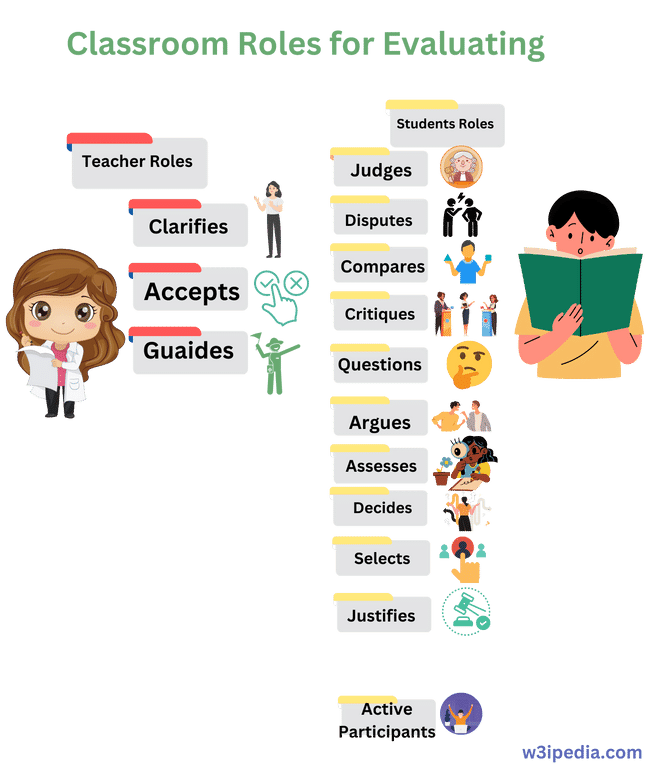
Evaluating: Engagement Activities and Products
- A letter should be written containing all the details and should be addressed to the letter editor (Publish a letter to the editor).
- For the debate, first of all, it should be seen which topic the debate should be, and then it should be prepared and then it should be conducted.
- Make a list of the evaluation standards.
- Make an argument for or against in an informative speech.
- Create a pamphlet outlining the five principles you consider to be most crucial. Influence others.
- Assemble a panel to debate various points of view.
- Inform them of the necessary adjustments in a letter.
- Produce a biannual report.
- Prepare a case in which to argue your viewpoint.
- Analyze the character’s deeds in the narrative.
6th Level: Creating
It involves the learner creating something new or developing new ideas and information using the abilities or knowledge gained in various past experiences.
For example, if someone decides to create a book about history, they will likely gather their information from a variety of sources to produce a new, comprehensive book.
- Designing
- Establishing
- Planning
- Producing
- Inventing/Making new ideas
- Devising
- Making
6th Level: Creating
It involves the learner creating something new or developing new ideas and information using the abilities or knowledge gained in various past experiences.
For example, if someone decides to create a book about history, they will likely gather their information from a variety of sources to produce a new, comprehensive book.
- Designing
- Establishing
- Planning
- Producing
- Inventing/Making new ideas
- Devising
- Making
Can you create new items, concepts, or perspectives on things?
Keywords Verbs
| Compose | Formulate |
| Assemble | Organize |
| Improve | Invent |
| Act | Compile |
| Predict | Forecast |
| Devise | Produce |
| Propose | Blend |
| Construct | Set up |
| Invent | Originate |
| Plan | Prepare |
| Develop | Imagine |
| Generate |
Products include:
| Film | Story |
| Project | Plan |
| New Game | Song |
| Movies | Drama |
| News Headlines | Newspapers |
| News Articles | Advertisement |
| Painting | Complex Calculator Program C/C++ |
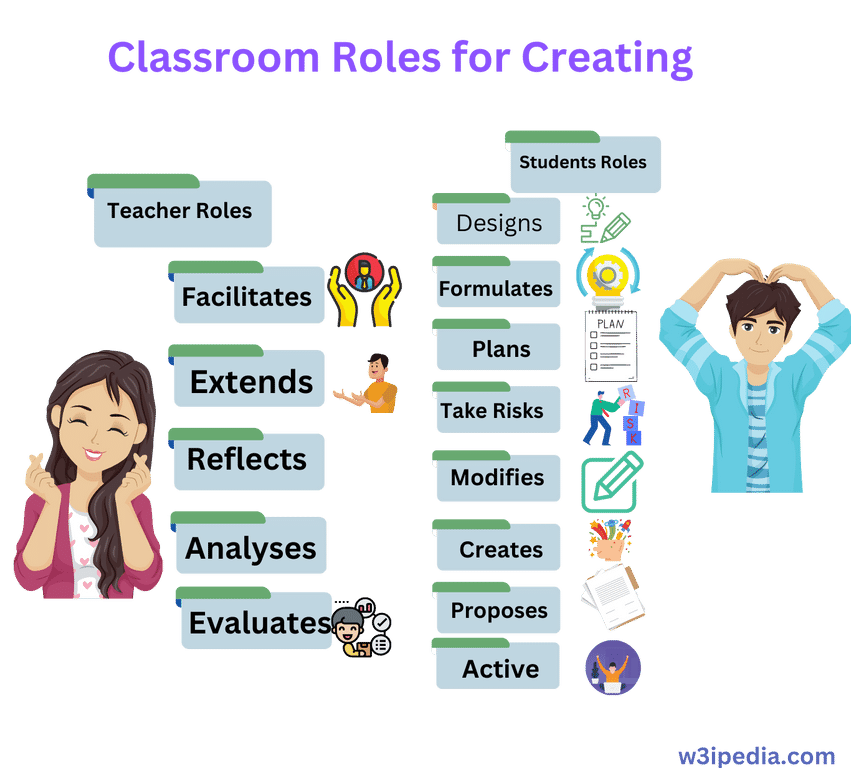
Making: Participation Products and Activities
- Create a brand-new kind of sports shoe by utilizing the SCAMPER method (SCAMPER Techniques=Generate New ideas)
- Design a machine that if you give it a specific task, will complete the task in the given time.
- Design an artificial intelligence machine that can help you with your household chores.
- Make a brand-new product. Create a name for it and develop a marketing strategy.
- Write about your emotions in your essay.
- Create a play, puppet show, role play, song, or pantomime based on the TV show.
- Create a new financial system.
- Create a new restaurant menu utilizing a choice of healthy foods.
- Create a book, record, or magazine cover.
- Give a strategy for selling ideas.
- Create a plan too.
- Create a new language, and then give an explanation using it.